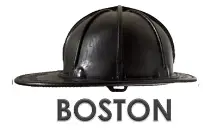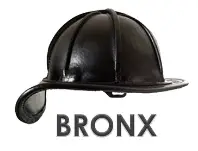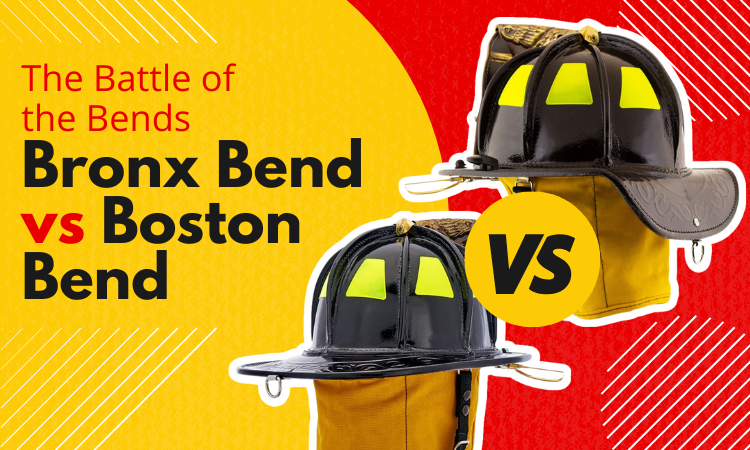When it comes to choosing a bend design for your firefighting helmet, there are many options to consider. Two popular choices are the Bronx Bend and the Boston Bend. They differ a lot in their appearance and hold different significance
So, between Bronx Bend vs Boston Bend, which is the better bend?
The Bronx bend has a near or complete 90-degree bent brim at the rear. In contrast, the brim of the Boston bend design is flat at the front, as well as the rear. The Bronx bent protects the neck against water and prevents hitting the cylinder and obstacles and is a bit more affordable. The Boston Bend, however, gives more freedom of movement.
In this comparison, we will take a closer look at the Bronx Bend and Boston Bend. This will help you make an informed decision when choosing the right bend.
Bronx Bend vs Boston Bend: A Quick Comparison
In this section I will be giving a quick comparison of the two leather firefighting helmet types:
| Criteria | Bronx Bend | Boston Bend |
| Defining feature | The rear is bent nearly or completely 90 degrees. The sides can be either flat or a bit curled. | The rear is completely flat |
| Making process | Soak the leather helmet in warm water completely. Fold the brim to the Bronx bend shape. Cool down the helmet using cold water. | Soak the leather helmet in warm water completely. Fold the brim to the Boston bend shape. Cool down the helmet using cold water. |
| Advantage | 1. The neck gets good protection from water.
2. Prevents the helmet from getting stuck in obstacles. 3. Does not hit the cylinder when crawling |
1. Easier to move your head.
2. Good protection for the neck. |
| History | Could have been inspired by the helmet designed by Henry T. Gratacap. May also have been invented to prevent the brim from hitting the oxygen cylinder that they were carrying when crawling around or looking up. | The shape of the brim is similar to that of the steel firefighting helmets issued in the UK during world war 2. The Boston Bend could have been inspired by that helmet. |
| Price | $1,505 to $1,600 | $1,515 to $1,610 |
Are you still confused about Bronx Bend vs Boston Bend? In the next section, I have given a more detailed comparison of the two.
Bronx Bend Vs Boston Bend: An In-Depth Comparison
There are a few differences between the Bronx Bend and the Boston Bend.
Defining feature:
The rear of the Bronx bend is bent nearly or completely by 90 degrees, while the Boston bend has a flat back.
This a Boston bend leather helmet:

The brim of the Boston bend design is completely flat overall. But the side may be a tiny bit curled. The Bron bend design, on the other hand, completely bends the back of the leather fire helmet:

The rear of the helmet is bent nearly or fully at 90 degrees. But the fronts of both the Bronx bend and Boston bend are co completely flat. The Bronx Bend design can also have curled-up sides as this picture shows:

Other than the brim both the Boston Bend and Bronx Bend do little to change the shape of the leather fire helmet. If you are interested in understanding why the helmets of firefighters are designed the way they are, take a look at FDNY shield meanings.
Making process:
Doing either the Bronx bend or the Boston bend on your leather fire helmet is a relatively easy process.
Bronx Bend:
Follow these steps to do the Boston bend design:
Step 1: Take a sink. The sink should be deep enough so that you can submerge the leather helmet in it completely.
Step 2: Fill up the sink with hot water. The temperature of the water should be close to 200° F. The water level should be slightly above the top of the helmet.
Step 3: Leave the helmet submerged in the hot water for about 5 minutes.
Step 4: Using a thick glove gently press on the helmet. If the helmet is still too hard let it soak for a few more minutes. Then press the helmet again to feel its rigidity. If the helmet still feels too hard keep the helmet soaking in hot water until the leather is soft enough to bend.
Step 5: Remove the helmet from the sink using thick gloves.
Step 6: Grab the leather helmet and apply downward force to the rear brim of the helmet to bend it.
Step 7: While bending the brim ensure that the wire inside the brim also gets bent to the correct shape to support the new design.
Step 8: If the brim of the helmet is refusing to bend easily do not force it. Forcing it to bend can damage the helmet. Instead, put the helmet back into 200° F hot water and soak it until it becomes soft enough to bend again.
Step 9: After bending your leather helmet, let it cool down at room temperature gradually.
You now have successfully created a Bronx bend.
Boston Bend:
Follow these steps to do the Boston bend design on your leather helmet:
Step 1: Follow steps 1 to 5 of the Bronx bend-making process.
Step 2: Grab the helmet while wearing the gloves and flatten out the brim of the helmet.
Step 3: Then follow steps 7 to 9 of the Bronx bend-making process.
Firefighters who often combat fire can use the heat from the fire to bend their helmets to the desired shape. But volunteer firefighters often do not see enough action and may have to resort to these processes for changing the bend. Even though they are not full-time firefighters, volunteer firefighters are heroes nonetheless.
Advantage:
The Bronx Bend protects the neck from the water and prevents the helmet from getting caught in obstacles or hitting the oxygen cylinder when crawling. The Boston bend design makes the helmet more protective of the neck due to the extended brim and makes head movement comparatively easier.
Because of these advantages manufacturers of modern helmets often incorporate these bends into helmets.
History:
It is very difficult to say how the Boston Bend or the Bronx Bend came into existence. The firefighting leather helmet was developed in the USA between 1821 and 1836 by the Luggage maker Henry T. Gratacap. The rear of the helmet developed by him also had an elongated rear brim known as the “duckbill” or the “beavertail”.
It is also theorized that the Bronx bend was intentionally done by firemen to avoid hitting their cylinders when crawling. The cylinders at that time were squared off at the end to withstand the pressure. The Bronx bend may also have been caused simply due to the intense heat faced by the firemen in their line of work.
The history of Boston Bend is unclear. But the shape of the brim is similar to that of the steel firefighting helmets issued in the UK during world war 2. The Boston bend could have been inspired by that helmet but was modified to get a longer brim at the rear. But the history of both the Bronx Bend and the Boston Bend is still unclear.
If you are curious about the history of firefighting you might want to know why firetrucks are red and not some other color.
Price:
The leather helmet with the Boston bend design will cost you about $10 more than the helmet with Bronx bend design. A Cairns Black N5A New Yorker with the Boston bend will typically cost you $1,515 to $1,610. A similar Cairns Black N5A New Yorker with the Bronx bend design, however, will cost you about $1,505 to $1,600.
So, Which is Better: Bronx Bend or Boston Bend?
Both the Boston bend and the Bronx bend in leather firefighting helmets have their merits. The Bronx bend channels water and debris away from the neck. The Boston bend, on the other hand, gives better protection to the neck due to the shape of the brim.
The Bronx bend, however, can help you avoid hitting your cylinder when crawling or looking up. The Bron bend is also less likely to hit obstacles due to the design. Whereas, the Boston bend may give you more freedom as the shape of the brim is relatively less restrictive. But the Boston bend design is about $10 more expensive.
Frequently Asked Questions (FAQs):
What is the difference between N5A and N6A?
The difference between N6A and N5A is the number of layers of the impact cap and their certification. The N5A has a double-layered impact cap and is certified by OSHA. The N6A, on the contrary, has a triple-layered impact cap and is certified by NPFA. This makes the N6A safer and heavier than the N5A.
What is the difference between OSHA and NFPA helmets?
The difference between OSHA helmets and NPFA helmets is the presence of eye protection. NPFA helmets must come with eye protection included. Moreover, the NPFA helmets also come with an NPFA certification sticker. Whereas the OSHA helmets do not have to incorporate eye protection and do not have to come with a certification sticker.
What is a TL 2 safety helmet?
The TL 2 safety helmet is a leather helmet with a traditional design. It is the lightest helmet which is also NPFA and OSHA certified. These helmets are made by hand and combine modern safety features with a traditional style.
Conclusion
So now you know almost all there is to know about Bronx Bend vs Boston Bend. These leather firefighting helmet designs have very few differences between them. But there are specific advantages to either design. I hope I managed to answer all your questions through this article.
That is all for today. Thank you and Goodbye!

